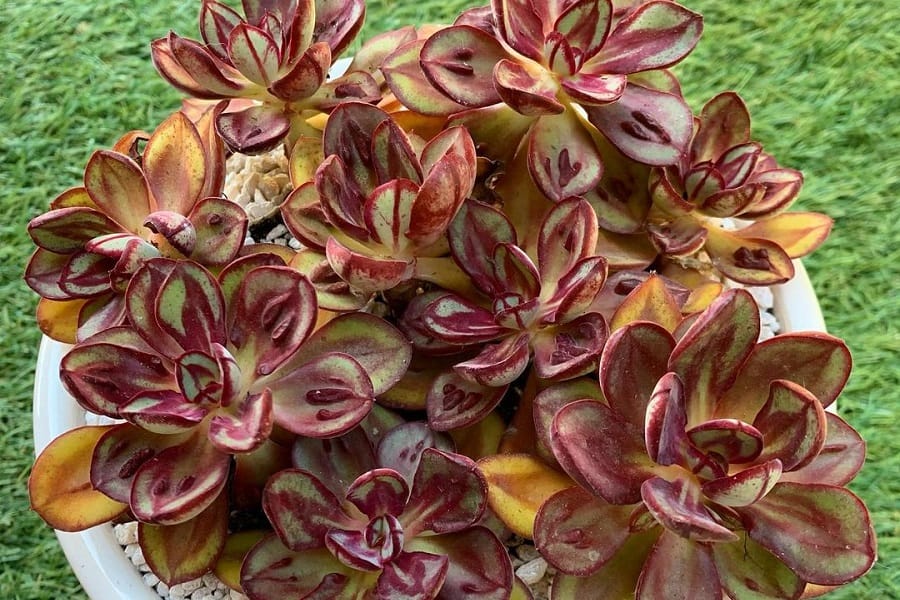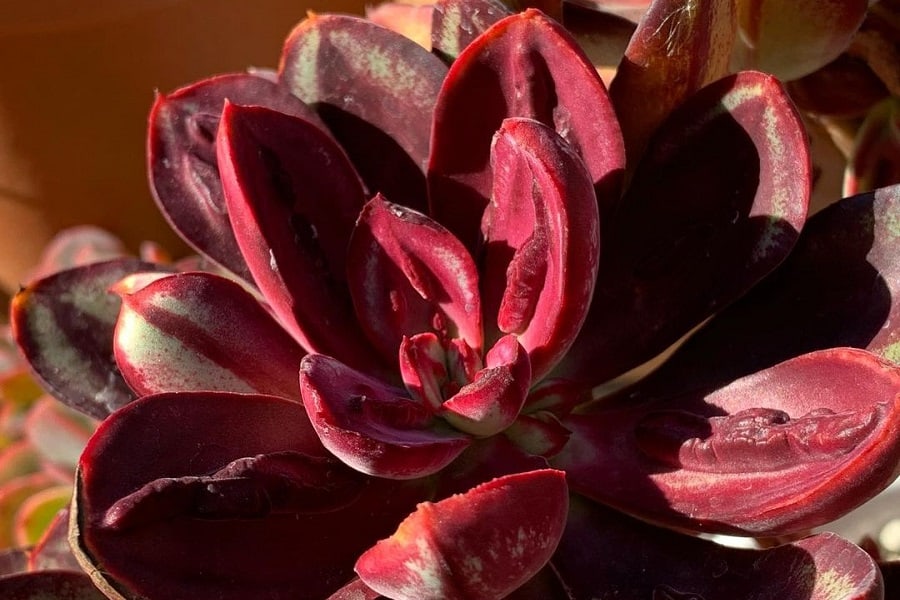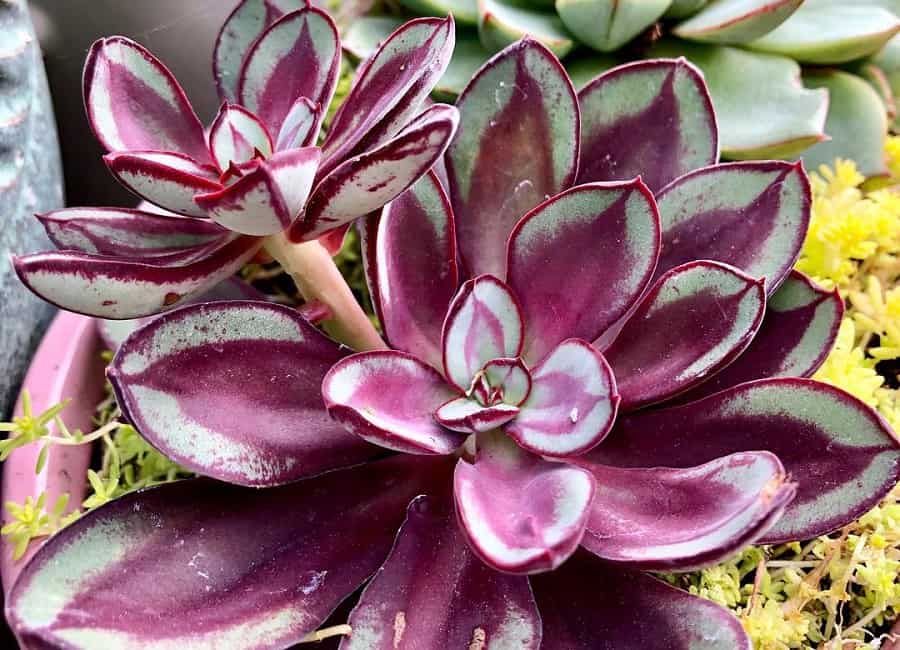Burgundy Beauty: Echeveria Benitsukasa Will Leave You Breathless
Have you ever seen a plant so captivating, it literally takes your breath away? Well, get ready to be dazzled by the magnificent Echeveria Benitsukasa! This succulent stunner is about to become your new obsession. With its maroon and burgundy hues and curiously ruffled leaves, it’s a showstopper that demands attention. But the real kicker? This petite plant is surprisingly low-maintenance. Keep reading to discover all the juicy details on keeping your Burgundy Beauty thriving!

Contents
About Echeveria Benitsukasa
This eye-catching succulent is a Japanese hybrid of the Echeveria nodulosa variety. While it grows in a similar rosette shape, Benitsukasa tends to produce even more of those gorgeous ruffled leaves that give it such an ornate, sculptural appearance. The leaves have curvy edges with a pale green center that transitions to reddish-burgundy tips. Seriously, it’s like Mother Nature’s work of art!
The coloring can vary based on the season and growing conditions. But that’s part of the fun – watching your plant’s hues shift and deepen is like getting a new specimen every few months. With proper care, this low-growing charmer will reward you with plenty of offsets for propagating and sharing the wealth.
Check this out:
160+ Amazing Echeveria Types with Pictures
Echeveria Benitsukasa Care Guide
Light Requirements
Echeveria Benitsukasa loves sunshine and needs at least 4-5 hours of direct, bright light daily. An unobstructed south or west-facing window is perfect. You can also use a grow light if you don’t get enough natural rays. Just keep the light source about 6-12 inches from the plant for 12-16 hours per day.
Too little light? Your plant will get leggy and stretched out as it desperately reaches for those rays. Too much intense, direct sun can lead to sunburn though, so go easy on the sun worship if you live in a blazing hot climate.
Water Needs
Like most succulents, Echeveria Benitsukasa is pretty drought-tolerant and stores water in its plump leaves. Only water when the soil is completely dry, then soak it thoroughly and allow the excess to drain away.
A good rule of thumb is to water every 10-14 days in the summer and just once a month during the winter dormancy. Signs of overwatering include wilting, wrinkling, or dropped leaves. Underwatering is better than drowning your thirsty buddy though! Always water the soil directly and avoid getting moisture trapped in the rosette center to prevent rot.

Soil Situation
Your potting mix makes or breaks succulent success! Echeveria Benitsukasa requires a very well-draining soil to prevent soggy roots and rot. Look for a cactus/succulent mix or amend regular potting soil by adding one part perlite or coarse sand for improved drainage.
Make sure any containers have adequate drainage holes as well. This Burgundy Beauty likes its soil on the drier side, but not total desert conditions. A moisture-retaining mix will spell disaster!
Temperature & Humidity
Benitsukasa prefers warm days around 65-80°F and slightly cooler nights in the 50-65°F range. It can handle average household humidity levels of 40-50% just fine. Much higher humidity encourages rot and fungi though.
In summer, you can put this heat-lover outside as temps climb into the 80s. Just provide some afternoon shade in scorching climates and avoid drafty areas in winter that could chill its roots.
Fertilizing
While not an absolute must, you can give your Echeveria a gentle nutrient boost during spring and summer growth periods. Use a balanced cactus/succulent fertilizer diluted to 1/4 or 1/2 strength and apply it every 4-6 weeks. Too much fertilizer can lead to chemical burn on those delicate leaves.
In winter when the plant is resting, skip the feed until spring rolls around again.
Pests & Problems
The biggest threat is overwatering leading to rot, mushiness, or pests like fungus gnats. Err on the dry side to keep problems at bay! Other potential issues include mealybugs leaving a cottony residue and stretching/legginess from insufficient light. Tidy up any dead or dying leaves or stem segments too.
Pruning
You won’t need to do much pruning beyond removing spent blooms or decrepit leaves. Use clean, sharp scissors or bypass pruners for any trimming tasks. This can help promote a fuller, tighter rosette shape too.
Potting and Repotting

When potting up, choose a container just slightly larger than the rootball with drainage holes. Repot every few years in late winter or early spring before active growth starts. Gently remove from the old pot, brush off excess soil, and replant in fresh succulent mix.
Allow the potting mix to dry out before attempting repotting. And go up just an inch or two in pot diameter to avoid that dreaded rot from oversized containers.
Echeveria Benitsukasa Propagation Methods
One of the best things about Echeveria Benitsukasa is how easy it is to propagate and multiply your collection! This prolific plant produces plenty of offsets, but you can also use leaf cuttings, stem cuttings, or seeds to grow new plants. Here are the different propagation methods:
Offsets
- Wait until you see offshoots forming around the base at least 2 inches wide.
- Gently detach them from the mother plant by twisting or cutting them off with a sharp, sterile knife.
- Allow the offsets to callus over for a few days before replanting in fresh succulent soil.
Leaf Cuttings
- Remove a firm, healthy leaf by gently twisting or cutting it from the stem.
- Allow the leaf to callus over for 3-5 days before laying on top of well-draining soil.
- Lightly mist the soil to keep it slightly moist but not soaked.
- In a few weeks, you should see new growth from the leaf.
- Once roots and a small rosette form, you can transplant it into its own pot.
Stem Cuttings
- Use a sharp, sterile knife or scissors to cut off a healthy stem segment from the main plant.
- Allow the cutting to callus over for 3-5 days before replanting.
- Place the stem vertically into well-draining soil, burying about 1/3 of the stem.
- Water sparingly until new growth emerges in 4-6 weeks.
Seeds
- Echeveria seeds are very tiny, so use a seed-starting tray with well-draining soil.
- Lightly press the seeds into the soil but don’t cover them.
- Keep the soil lightly misted and in a warm, bright location.
- Once sprouted, very gently brush away the seed husks.
- Transplant seedlings into their own pots once they’ve developed a few sets of true leaves.
No matter which method you choose, bright indirect light and well-draining soil are key for successfully propagating Echeveria Benitsukasa. With some patience, you’ll have plenty of new baby plants to share with friends or expand your collection!
